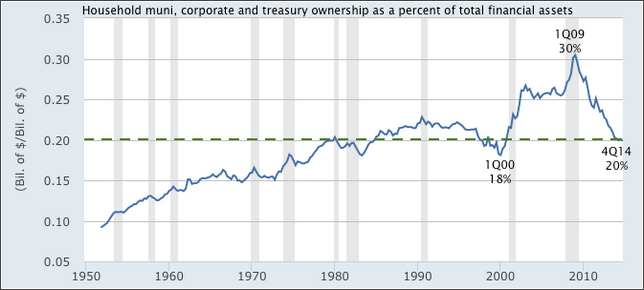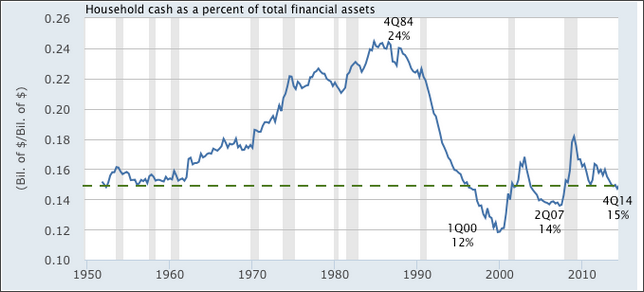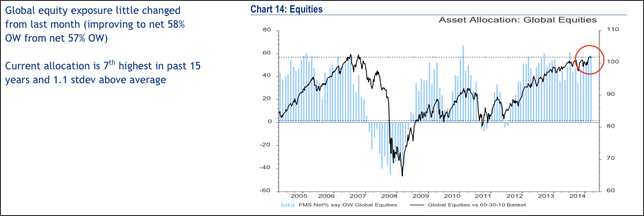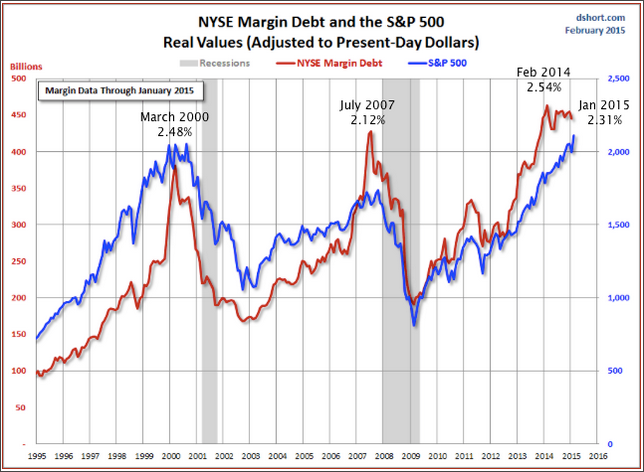The S&P 500 rose 30% in 2013. In 2014, it was up just over 10%. Since the start of the "best six months of the year for equities" in November (nearly 5 months ago), the index is up 4%.
Any number of factors could account for the slowing rate of appreciation in stocks: valuations and financial growth, not to mention the base effect of larger numbers. What impact might investor positioning have on price appreciation?
The story seems to be this: the strong price gains in 2013 and into 2014 coincided with households and investment funds increasing their asset allocation to equities. This period also coincided with money from corporate buybacks having a demonstrably large impact on share prices.
But funds and households now have a high level of exposure to equities; more to the point, their allocation is no longer rising. And buybacks are no longer outperforming the indices. It takes an increase in money flows to push equity prices higher, yet it's not clear from where the next huge source of additional demand for equities will come.
Household Fund Flows
Let's start with a quick review of the latest Federal Reserve flow of funds data on households' current asset allocation.
US household's largest holding is in equities; these comprise about 31% of their total financial assets. Current levels are above the 29% high at end of the last bull market in mid-2007. It reached an all-time high of 36% at the end of the 1990s bull market.
Household ownership of equities troughed at 18% in early 2009. That was lower than at any time since the recession in 1991. So in the past 6 years, there has been a significant increase in household equity ownership. Looking at the chart above, the recent rate of increase is second only to that during the 1990s.
Treasury, corporate and muni bonds are about 20% of household financial assets. Overall, fixed income ownership is near a 35 year low. The only time is was lower since then was at the end of the 1990s bull market.
Finally, checking and savings deposits and money market funds (cash) are the smallest part of household financial assets. Current levels of 15% are near the most recent bottom of 14% in mid-2007 as well as the lows in the 1950s and early 1960s. In 2000, it reached an extreme low of 12%.
So, overall, households have reduced their allocation to fixed income and cash, placing the money in equities. This coincides with the rise in equity prices over the past 6 years. On a relative basis, household allocation to equities, fixed income and cash is now near the long-term highs and lows, respectively, excluding the anomalous period in the late 1990s.
In this respect, households are similar to global fund managers. As measured by BAML, fund managers currently have one of their most overweight positions in equities since their survey began 15 years ago. In fact, their equity allocation has been high for most of the past two years, an unusually long period of time.
The flow of money moves equity prices higher and lower. The fund manager data from BAML shows that the boom in 2013 came as funds increased their equity allocations from mid-30% to nearly 60% overweight. Those equity allocations are now at a level from which they have not, in the past, been able to move much higher. In other words, it will require new money, not higher allocations, for funds to move equity prices higher.
Back at the US household level, what is becoming noteworthy is that households have not increased their proportional ownership of equities in the past year. The current 31% is just 1 percentage point higher than in 1Q 2014. During the rapid price appreciation in 2013, US household ownership of equities increased 4 percentage points, from 26% to 30%.
We don't know if the current trend of negligible increases in equity ownership will continue. If it does, take note in the chart above of the period between in 2004 and 2005. There was just a small increase in equity ownership and during most of that period, the S&P 500 was nearly flat.

The (possibly) waning appetite for equities is also reflected in the recent margin debt data. Margin debt peaked above the March 2000 highs (as a percent of market cap) a full year ago. Since then, margin debt has not increased, another source of additional money to push equity price higher having seemingly plateaued.
The current meme is that corporate buybacks will push equities higher. Certainly, the money from corporates is an important source of equity demand, although a sizable portion is used to mop up share issuance from, for example, executive compensation.
It's noteworthy that the companies who are buying their own shares (represented in the buyback index, PKW) have not appreciated faster than the overall market over the past 18 months. Equally, its noteworthy that the strong gains in 2013 coincided with the very strong out-performance from companies doing buybacks. Again, the S&P 500 was up 30% in 2013, so the performance of buyback companies was truly extraordinary.
In summary, investors, large and small, have a high allocation to equities and those allocations seem to no longer be rising. Margin debt has flatlined. And whatever impact buybacks had in raising equities seems to be waning.
We're not sounding an alarm but it takes increasing money flows to push equities higher and its not immediately clear from where the next huge source of additional demand for equities will come.
